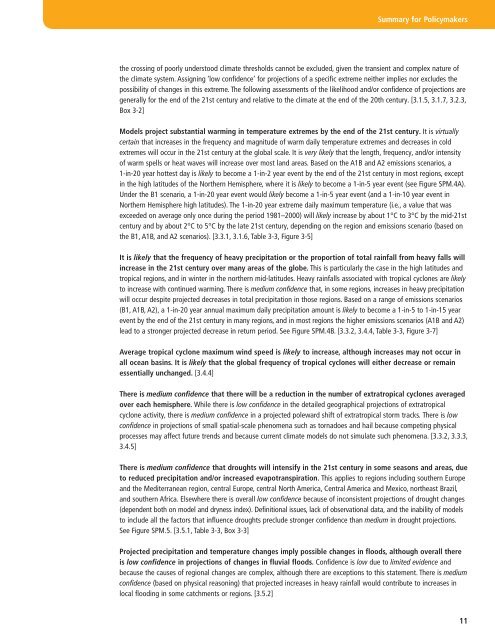Summary for Policymakers - IPCC
Summary for Policymakers - IPCC
Summary for Policymakers - IPCC
Create successful ePaper yourself
Turn your PDF publications into a flip-book with our unique Google optimized e-Paper software.
<strong>Summary</strong> <strong>for</strong> <strong>Policymakers</strong><br />
the crossing of poorly understood climate thresholds cannot be excluded, given the transient and complex nature of<br />
the climate system. Assigning ‘low confidence’ <strong>for</strong> projections of a specific extreme neither implies nor excludes the<br />
possibility of changes in this extreme. The following assessments of the likelihood and/or confidence of projections are<br />
generally <strong>for</strong> the end of the 21st century and relative to the climate at the end of the 20th century. [3.1.5, 3.1.7, 3.2.3,<br />
Box 3-2]<br />
Models project substantial warming in temperature extremes by the end of the 21st century. It is virtually<br />
certain that increases in the frequency and magnitude of warm daily temperature extremes and decreases in cold<br />
extremes will occur in the 21st century at the global scale. It is very likely that the length, frequency, and/or intensity<br />
of warm spells or heat waves will increase over most land areas. Based on the A1B and A2 emissions scenarios, a<br />
1-in-20 year hottest day is likely to become a 1-in-2 year event by the end of the 21st century in most regions, except<br />
in the high latitudes of the Northern Hemisphere, where it is likely to become a 1-in-5 year event (see Figure SPM.4A).<br />
Under the B1 scenario, a 1-in-20 year event would likely become a 1-in-5 year event (and a 1-in-10 year event in<br />
Northern Hemisphere high latitudes). The 1-in-20 year extreme daily maximum temperature (i.e., a value that was<br />
exceeded on average only once during the period 1981–2000) will likely increase by about 1°C to 3°C by the mid-21st<br />
century and by about 2°C to 5°C by the late 21st century, depending on the region and emissions scenario (based on<br />
the B1, A1B, and A2 scenarios). [3.3.1, 3.1.6, Table 3-3, Figure 3-5]<br />
It is likely that the frequency of heavy precipitation or the proportion of total rainfall from heavy falls will<br />
increase in the 21st century over many areas of the globe. This is particularly the case in the high latitudes and<br />
tropical regions, and in winter in the northern mid-latitudes. Heavy rainfalls associated with tropical cyclones are likely<br />
to increase with continued warming. There is medium confidence that, in some regions, increases in heavy precipitation<br />
will occur despite projected decreases in total precipitation in those regions. Based on a range of emissions scenarios<br />
(B1, A1B, A2), a 1-in-20 year annual maximum daily precipitation amount is likely to become a 1-in-5 to 1-in-15 year<br />
event by the end of the 21st century in many regions, and in most regions the higher emissions scenarios (A1B and A2)<br />
lead to a stronger projected decrease in return period. See Figure SPM.4B. [3.3.2, 3.4.4, Table 3-3, Figure 3-7]<br />
Average tropical cyclone maximum wind speed is likely to increase, although increases may not occur in<br />
all ocean basins. It is likely that the global frequency of tropical cyclones will either decrease or remain<br />
essentially unchanged. [3.4.4]<br />
There is medium confidence that there will be a reduction in the number of extratropical cyclones averaged<br />
over each hemisphere. While there is low confidence in the detailed geographical projections of extratropical<br />
cyclone activity, there is medium confidence in a projected poleward shift of extratropical storm tracks. There is low<br />
confidence in projections of small spatial-scale phenomena such as tornadoes and hail because competing physical<br />
processes may affect future trends and because current climate models do not simulate such phenomena. [3.3.2, 3.3.3,<br />
3.4.5]<br />
There is medium confidence that droughts will intensify in the 21st century in some seasons and areas, due<br />
to reduced precipitation and/or increased evapotranspiration. This applies to regions including southern Europe<br />
and the Mediterranean region, central Europe, central North America, Central America and Mexico, northeast Brazil,<br />
and southern Africa. Elsewhere there is overall low confidence because of inconsistent projections of drought changes<br />
(dependent both on model and dryness index). Definitional issues, lack of observational data, and the inability of models<br />
to include all the factors that influence droughts preclude stronger confidence than medium in drought projections.<br />
See Figure SPM.5. [3.5.1, Table 3-3, Box 3-3]<br />
Projected precipitation and temperature changes imply possible changes in floods, although overall there<br />
is low confidence in projections of changes in fluvial floods. Confidence is low due to limited evidence and<br />
because the causes of regional changes are complex, although there are exceptions to this statement. There is medium<br />
confidence (based on physical reasoning) that projected increases in heavy rainfall would contribute to increases in<br />
local flooding in some catchments or regions. [3.5.2]<br />
11

















